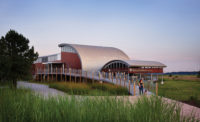
Jason F.
McLennan
Jason F. McLennan thinks of himself as a green warrior. One of his email addresses is even greenwarrior@earthlink.net. Yet McLennan started a peaceful “evolution” to make the world a better place through more-sustainable built environments. And the symbol of his rigorous program—the Living Building Challenge—is not a weapon but a flower.
In a way, however, McLennan has declared war on buildings, which are the world’s worst power users, water hogs and polluters. Buildings account for 39% of carbon dioxide emissions in the U.S., according to the U.S. Dept.of Energy.
McLennan’s most powerful weapon, to date, is the Living Building Challenge sustainability certification program, which he launched in 2006.
LBC goes way beyond the U.S. Green Building Council’s popular LEED rating system, especially because it puts limits on the amount of energy and water used by occupants and operators. The highest level of certification, a Living Building, requires net-zero annual energy and water use, among other performance areas. No Living Building is certified before a year of successful operation.
![]() “Early on, a lot of people thought the Living Building Challenge was too difficult and expensive,” says McLennan. “There was a huge litany of excuses.”
“Early on, a lot of people thought the Living Building Challenge was too difficult and expensive,” says McLennan. “There was a huge litany of excuses.”
That was then. The LBC is catching on. Around the globe, there are more than 300 registered projects, representing more than 11 million sq ft. “People no longer say they can’t,” says McLennan.
The LBC includes seven performance areas, called “petals”: place, water, energy, health and happiness, materials, equity and beauty. Teams can meet any number of performance areas. If a team meets all seven, the building is declared a Living Building. The group also created a Living Communities Challenge.
Through the International Living Future Institute, which McLennan founded in 2011 to administer all the programs of the LBC, McLennan developed the world’s first certification program for net-zero annual energy use. He started Declare, the world’s first building-materials ingredient label, and the Red List, the first list of harmful chemicals in many building products.
McLennan also created the first transparency label for building energy use. Called Reveal, it recently entered the market.
Since 2006, the McLennan, his team and the early adopters of the LBC have changed state and local laws around water and waste that had made it impossible to do a Living Building. These changes have resulted in reducing water use by millions of gallons each year, says McLennan.
The Phipps Conservatory and Botanical Gardens, in Pittsburgh, is working on its third Living Building. The first project—which is net-positive, not just net-zero—has “no electric, water, cooling or heating bills,” says Richard Piacentini, Phipps’ executive director.
Satisfied that the Living Future Institute is on a healthy course, McLennan is returning to the production of extreme-green architecture. On Jan. 1, he stepped down as the group’s CEO, though he is chairman of the board. Amanda Sturgeon, executive director, is his successor.
McLennan has formed McLennan Design with partners Tom Knittel and Dale Duncan. The firm is targeting clients of means to fund deep-green projects. McLennan also is launching a charitable group, called the Green Warrior Society. He hopes to donate 20% of the firm’s time to deep-green projects for the underserved and needy. “It’s a bit of a Robin Hood model,” says McLennan.
Two pro-bono pilot projects are the William Jefferson Clinton Children’s Center, an orphanage in Haiti, and Save a Warrior Village, a project in Kansas City, Mo., that will help U.S. veterans and first responders deal with post-traumatic stress disorder. The orphanage is scheduled to break ground next month. The village is currently under design.
“Jason is an incredible visionary, not only concerning the Living Building Challenge, which is so important on so many levels, but because he is constantly thinking about new things,” says Piacentini. “He keeps raising the bar.”





Post a comment to this article
Report Abusive Comment